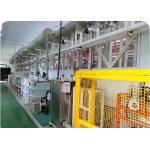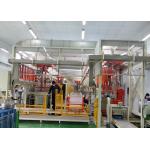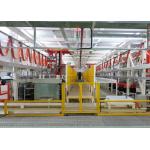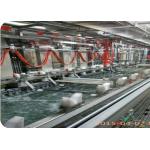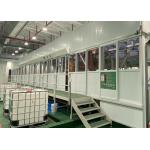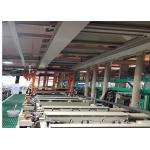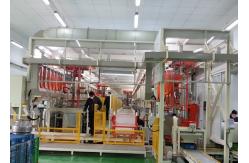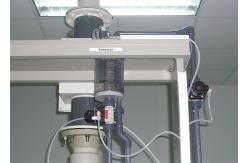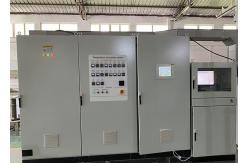In the automotive and electronics industries, the quality of metal
plating on components and printed circuit boards (PCBs) is non -
negotiable. It directly impacts the performance, durability, and
aesthetic appeal of the final products. High - efficiency automatic
machinery designed for PCB electroplating in these sectors has
become a cornerstone of modern manufacturing processes. This
equipment is engineered to meet the unique demands of automotive
and electronic applications, ensuring precision, speed, and
reliability in metal plating. - Automotive - grade Durability: For automotive applications, the plating equipment is designed to
deposit coatings that can withstand harsh operating conditions.
Whether it's extreme temperatures, vibrations, or exposure to
corrosive substances, the plated components need to maintain their
integrity. The equipment can precisely control the thickness and
composition of the plating layers. For example, in plating
automotive engine components, a thick and corrosion - resistant
nickel - based coating can be applied with tight tolerance to
ensure long - term performance.
- electronic - specific Electrical Performance: In the electronics industry, especially for PCBs, the focus is on
electrical conductivity and signal integrity. The automatic
machinery can selectively plate areas on the PCB with high -
conductivity metals like copper. The control system ensures that
the copper layer is uniform, minimizing resistance and signal loss.
This is crucial for high - speed data transfer in modern electronic
devices.
- Fully Automated Workflow: The equipment features a fully automated workflow that
streamlines the entire electroplating process. From the moment the
PCBs or automotive components enter the system, pre - treatment
steps such as degreasing, cleaning, and surface activation are
carried out automatically. This is followed by the actual
electroplating process, where parameters like current density,
plating time, and temperature are precisely controlled. Post -
treatment processes, including rinsing, drying, and passivation,
are also automated. This seamless automation not only reduces human
error but also significantly increases the production rate.
- Real - time Monitoring and Adjustment: A sophisticated monitoring system is integrated into the
equipment. Sensors throughout the plating process continuously
measure parameters such as chemical concentrations in the plating
bath, electrical currents, and temperatures. The data is fed into a
central control unit, which can make real - time adjustments to
ensure the plating process remains within the optimal range. If the
copper concentration in the plating bath drops slightly, the system
can automatically add the appropriate amount of copper solution.
- Large - capacity Design for Volume Production: The plating chambers are designed with a large - capacity in mind
to meet the high - volume production requirements of both the
automotive and electronics industries. In the automotive sector,
where thousands of components may need to be plated daily, the
chambers can accommodate a significant number of parts
simultaneously. Similarly, for high - volume PCB manufacturing, the
chambers can hold multiple boards, ensuring efficient use of
resources and time.
- Optimized for Uniform Coating Distribution: To ensure uniform plating across all components or PCBs in the
chamber, advanced agitation and circulation systems are employed.
These systems ensure that the plating solution reaches every part
of the workpiece evenly. In the case of complex - shaped automotive
components or densely - populated PCBs, this is essential for
achieving a consistent coating thickness and quality.
- Energy - efficient Operation: The machinery is designed with energy - saving features. For
example, the power supply to the plating process is optimized based
on the real - time requirements. When the plating process nears
completion, the power can be reduced without affecting the quality
of the coating. Additionally, the heating and cooling systems are
designed to consume minimal energy while maintaining the required
temperature in the plating bath.
- Environment - friendly Chemical Management: In both the automotive and electronics industries, environmental
regulations are strict. The plating equipment is equipped with a
chemical management system that reduces waste and ensures proper
disposal of chemicals. Filtration systems are used to clean the
plating solution, extending its lifespan and reducing the need for
frequent replacements. Moreover, the equipment can recover and
recycle certain valuable metals from the waste stream, minimizing
the environmental impact.
| Machine type | Plating Machine | | Warranty | 1 Year | | Weight(kg) | 130000 | | Test Report | Provided | | Core components | PLC, Engine, Bearing, Gearbox, motor | | dimension(l*w*h) | Customized | | key selling points | Easy to Operate | | Material of Framework | Square Steel Pipe | | Material of Tank | PP, PVC, Stainless Steel | | Control System | PLC Control System | | Model Type | Full-Automatic, Semi-Automatic, Manual | | Pre-Treatment System | Washing Equipment, Degreasing Equipment, etc. | | After-Treatment System | Washing Equipment, Drying etc | | Auxiliary Equipment | Rectifier, Dryer, Filter and Waste Gas Treatment Equipment etc | | Application | Metal Surface Plating | | Output | Customized |
|
